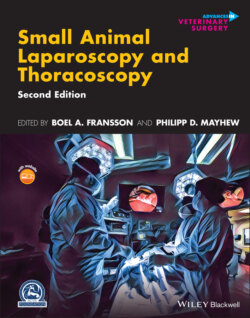Читать книгу Small Animal Laparoscopy and Thoracoscopy - Группа авторов - Страница 37
Life‐like‐High Fidelity‐ Training
ОглавлениеIn addition to the fundamental psychomotor skills, the complex skills of MIS surgery require an additional variety of training; in lifelike scenarios such as fresh cadavers, live animal models, and apprentice training in surgery. (Figure 1.13) In particular, surgery training programs who lack experienced MIS surgeons on staff, may have problems providing a broad and varied training program to their residents. Also, surgery practitioners wanting to develop MIS skills are limited in options. Currently, industry‐supported commercial short courses, utilizing live models, provide training opportunities for veterinarians. Limited live training opportunities using ovariectomy as a model surgery is also available for ACVS residents. Hopefully the future brings a concerted effort to combine similar efforts into a comprehensive and effective training program for all veterinary surgeons.
Very few high‐fidelity veterinary simulation models are commercially available. Ideally, such analog models should be low cost, physiologically and anatomically similar to dogs and cats, and with inherent means of objective assessment of the skills. For training of M.D. surgeons, a number of procedures have been identified for which simulator models have been developed. Hopefully, the future will see a similar development on the veterinary side. Until then, some of the models used for M.D. surgeons may have value. However, prior to training programs investing in costly tools, the models need validation. Validation evidence is a complex subject [38, 39], but as a concept aims to show that the model represents the intended skills and is clinically relevant. This often starts with face and content validation. If a veterinary expert, with ample experience of successfully performing the particular surgery, is not able to do the simulated procedure effectively, the model content may be faulty (“too hard”). The model anatomy or physiology may be different enough to not effectively simulate veterinary conditions. Conversely, if a novice seems to perform the procedure more effectively than a laparoscopic expert, the model content may not be of appropriate challenge level (“too easy”). Even if the content of the model is validated, simply having the model available for trainees will not reach educational goals. Use of such models does not circumvent the need for principles of deliberate practice. The trainee needs to be at the appropriate training level for the modeled procedure, know the training goals and objectives, and will need individual feedback to truly benefit.
Figure 1.13 Graphic representation of an ideal training program, balanced with concern for patient safety. Training starts with simulation task training such as a VALS‐like curriculum until passing competency assessment. Thereafter high‐fidelity models such as training in fresh cadavers takes place, prior to training on a live animal model. After these steps, the trainee should be ready to perform basic MIS procedures on patients, under supervision of an experienced MIS surgeon. Advancing the level of surgeries would ideally start with fresh cadaver exercises followed by practice in a live model, before attempting advanced procedures on animal patients. It is likely that training of a fully competent MIS surgeon, able to safely do advanced procedures on patients, is beyond the goal of ACVS resident training. Training such as ACVS Fellowship may be required to reach that level.
